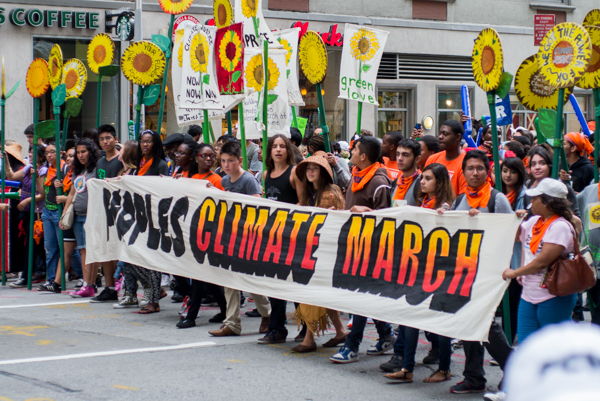

With stakes like the entire planet on the line, New Paltz residents came together in busloads to participate in the world’s largest ever climate change march.
The Sept. 21 New York City march, which brought in nearly 400,000 people, sparked similar calls for action at over 2,700 events in more than 150 countries, according to the People’s Climate March website.
New Paltz residents flocked to the march in a coordinated effort and made their impact.
Eight buses with more than 400 students and community members left New Paltz last Sunday to be part of history, according to Eric Wood, the SUNY New Paltz New York Public Interest Research Group (NYPIRG) coordinator.
NYPIRG Intern Terence Gagstetter, a third-year political science major, liked how well New Paltz came together for this event.
“It was great to put New Paltz on the map in such large numbers while taking part in a crucial turning point in environmental activism and our nation’s history,” Gagstetter said.
The march was in response to an emergency UN Climate Summit, which ultimately made substantial environmental pledges. Wood said the voice of people at the march had a direct impact on action taken in the summit.
“I definitely think the UN leaders were paying attention to what was going on in New York that day,” Wood said. “And from what I can gather, some aggressive policies for climate change crisis solutions have been being brought to the table during the summit this week.”
At the summit, six countries pledged $2.3 billion for climate aid over the next few years. A major declaration regarding forests was signed by 27 governments and more than 100 companies and organizations. They committed to end global deforestation by 2030, despite Brazil’s refusal to participate, according to the UN’s website.
Ann Guenther of the New Paltz Climate Action Coalition said she was part of the march, not just for her fellow humans, but for every species on the planet.
“It’s their future. We’re all involved,” she said. “This is one of the few opportunities to make a statement this big. It’s much more impressive than changing your light bulb.”
Some big name participants in the march included UN Secretary General, Ban Ki Moon, New York City Mayor Bill de Blasio, Former Vice President Al Gore and even celebrities like Leonardo di Caprio, Sting and Mark Ruffalo.
The most intense moment of the march was the moment of silence that took place from 12:58-1:00 p.m. to honor people affected by climate change, according to Wood.
“It was the most quiet I have ever heard downtown Manhattan in the biggest crowd I have ever been in there,” he said. “The wave of noise following the silence was one of the most intense things I have ever experienced.”
The march seemed to make a difference particularly at the state level.
The day after the march, Governor Cuomo declared Sept. 22-28 “Climate Week” in the New York Constitution.
“A good way for him to celebrate this would be to ban fracking in [the state], as the methane emissions from fracking are a huge contributor to climate change,” Wood said. “Also, both Cuomo and Obama not only need to ban fracking, they need to implement policies that will curb CO2 emissions from coal burning power plants. They also need to heavily invest in more clean, green renewable energy technology, like wind and solar power.”
Wood noted all of the ways New Paltz is trying to make a difference.
Bill McKibben, an environmentalist, author and founder of 350.org, gave a lecture at SUNY New Paltz on Tuesday, Sept. 16 in preparation for the New York City event entitled “On to New York: Why the Climate Movement is on the March.”
“It is not we who are destroying [the planet], but a small number of people who have grabbed power,” he said, placing blame on corporation owners like the Koch brothers.
McKibben said these people are on track right now to raise the planet temperature four to five degrees celsius in this century; results he said, that would be catastrophic.
On Monday, Sept. 22, NP Unplugged, a competition between the residence halls to reduce energy on the New Paltz campus, began. Last year the campus saw a seven percent reduction and the university has a nine percent goal this year.
Wood said attending meetings with the Climate Action Coalition (CAC), Environmental Task Force (ETF) and NYPIRG are ways people can locally get involved in the fight against climate change.
CAC meets Thursdays at 5:30 p.m. in the Village Hall and NYPRIG’s General Interest Meeting is Wednesday Oct. 1 at 7 p.m. in Student Union 409. ETF meets this Tuesday at 1:45 p.m. in JFT 1010.
